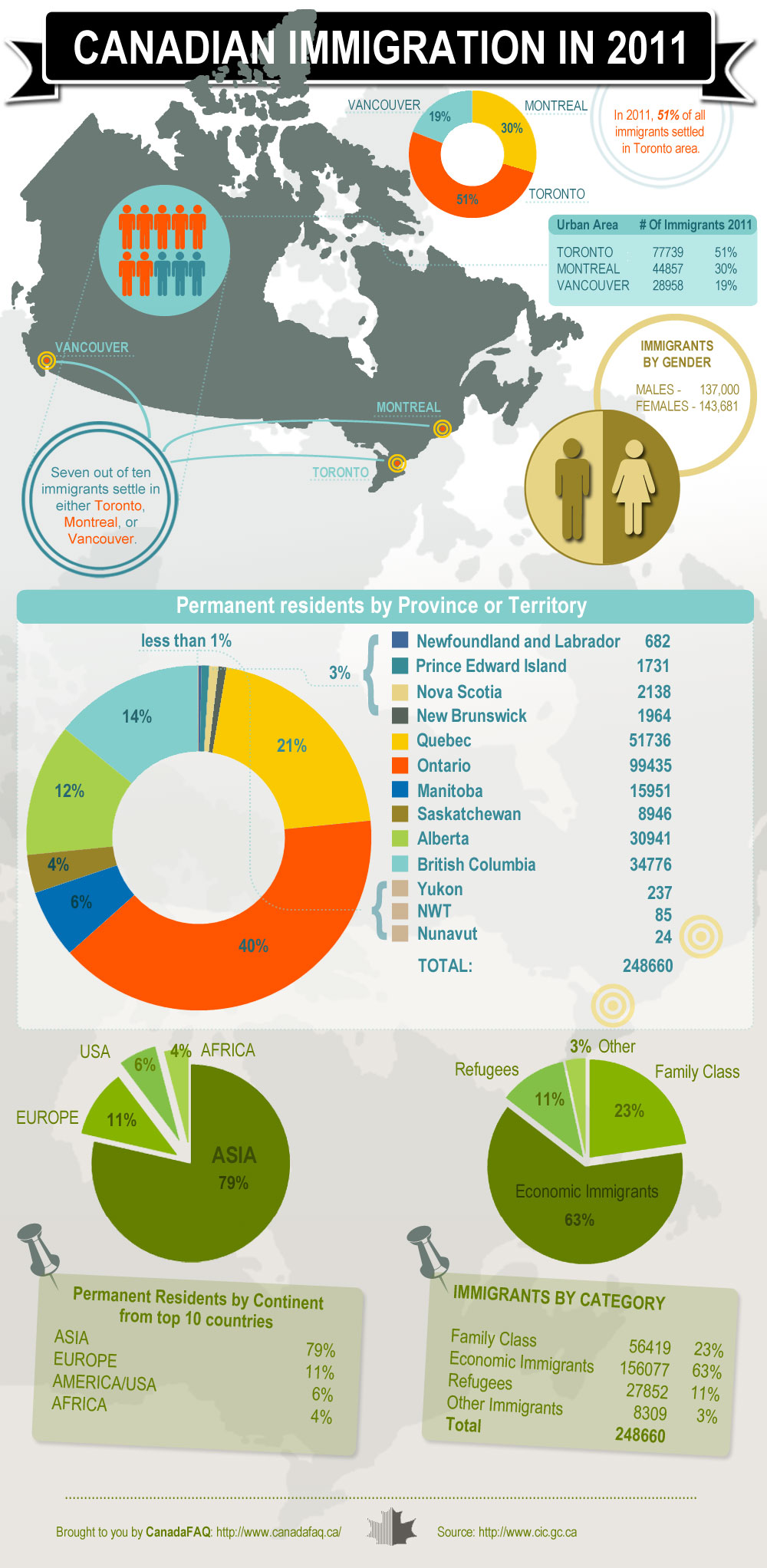Canadian Immigration Facts & Statistics
Embedding the infographic on your blog or website is very easy and you'll find instructions how to do it here.
This infographic is licensed through the Creative Commons Attribution-No Derivatives License which allows redistribution both commercial and noncommercial as long as it is unchanged and credited to CanadaFAQ.ca.

Embed this Infographic on your site using the HTML code below:
Each year, Canada receives thousands of immigrants from all over the world. The country welcomes foreign students, temporary foreign workers, immigrants, and refugees from over 200 countries.
Immigrants settle in all provinces and territories, but as the infograph shows, 7 out of 10 newcomers (or 51 percent in 2011) choose to settle in Vancouver, Montreal, and Toronto. Most immigrants prefer urban areas to predominantly rural regions. Thus, provinces with large urban centres such as British Columbia and Ontario attract the most immigrants. In fact, the infograph illustrates that 40 percent of all permanent residents settle in Ontario, and less than 1 percent chooses Nunavut, the Northwest Territories, and Yukon. The rural regions of the five eastern provinces and Saskatchewan receive the least immigrants. These findings are important in light of the fact that immigration is the main driving force of population growth. The Atlantic provinces receive fewer immigrants, and retention rates are considerably lower. Retention rates range from 43 to 68 percent in Manitoba, Saskatchewan, and the Atlantic provinces and from 79 to 91 percent in Quebec, Alberta, British Columbia, and Ontario. There are two challenges that call for a community development strategy – to attract immigrant groups to the provinces with lower retention rates and to keep them there. Community development strategies help meet the long-term requirements of the labor market as well as regional skill shortages. The aim is to attract and retain skilled and qualified workers across Canada.
The infograph also presents information about immigrants by gender and offers two graphs, showing the percentage distribution of immigrants by continent and status. Most immigrants come from Asia (79 percent) and the least from Africa (4 percent). The figures are 11 percent for Europe and 6 percent for the United States. These numbers are important given that different population groups may face different and unique challenges. A study by Desai and Subramanian, for example, reveals that adolescents of South Asian origin face adjustment problems in addition to developmental challenges. The reason is that they face conflicts between the culture of origin and the host culture.
The second graph is important in that it shows that immigrants come to Canada with different experiences (business immigrants, economic immigrants, family class, etc). Many of them are selected based on their qualifications and skills. There are myths and misconceptions about immigrants that create negative attitudes toward them. Many believe, for example, that immigrants prefer to live on social assistance and are drain on society. Another myth is that newcomers are uneducated and unskilled and receive special treatment. In fact, the graph illustrates that the majority of newcomers or 63 percent of them are economic immigrants, followed by family class (23 percent). The economic class includes provincial nominees, business immigrants, and skilled workers who are selected based on their qualifications, skills, and ability to contribute to Canada’s economy. The group of business immigrants encompasses investors, self-employed people, and entrepreneurs. Refugees and other immigrants represent 11 percent and 3 percent of all immigrants.
Regardless of their status, newcomers are entitled to the same treatment as Canada-born citizens. They have to declare income and pay taxes and receive the same tax credits (Harmonized Sales Tax and Child Tax Benefit) as Canadians. Immigrants are not eligible to receive additional tax credits. Moreover, they rely less on social assistance than other groups.
In sum, the infograph gives an insight into broader immigration trends that can help outline and improve community development strategies, thus facilitating economic growth and wellbeing. The infograph also shows that while different immigrant groups may face different challenges, the majority of newcomers are selected based on skills and educational qualifications.
